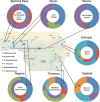Tick communities of cattle in smallholder rural livestock production systems in sub-Saharan Africa
- PMID: 37337296
- PMCID: PMC10280850
- DOI: 10.1186/s13071-023-05801-5
Tick communities of cattle in smallholder rural livestock production systems in sub-Saharan Africa
Erratum in
-
Correction: Tick communities of cattle in smallholder rural livestock production systems in sub-Saharan Africa.Parasit Vectors. 2023 Aug 9;16(1):272. doi: 10.1186/s13071-023-05895-x. Parasit Vectors. 2023. PMID: 37559151 Free PMC article. No abstract available.
-
Publisher Correction: Tick communities of cattle in smallholder rural livestock production systems in sub-Saharan Africa.Parasit Vectors. 2023 Nov 16;16(1):423. doi: 10.1186/s13071-023-06034-2. Parasit Vectors. 2023. PMID: 37974204 Free PMC article. No abstract available.
Abstract
Background: The majority of the African population lives in rural areas and depends on agriculture for their livelihoods. To increase the productivity and sustainability of their farms, they need access to affordable yield-enhancing inputs of which parasite control is of paramount importance. We therefore determined the status of current tick species with the highest economic impact on cattle by sampling representative numbers of animals in each of seven sub-Saharan countries.
Methods: Data included tick species' half-body counts from approximately 120 cattle at each of two districts per country, collected four times in approximately 1 year (to include seasonality). Study sites were chosen in each country to include high cattle density and tick burden.
Results: East Africa (Ethiopia, Uganda and Tanzania) showed overall a higher diversity and prevalence in tick infestations compared to West African countries (Benin, Burkina Faso, Ghana and Nigeria). In East Africa, Amblyomma variegatum (vector of Ehrlichia ruminantium), Rhipicephalus microplus (Babesia bovis, B. bigemina, Anaplasma marginale), R. evertsi evertsi (A. marginale) and R. appendiculatus (Theileria parva) were the most prevalent tick species of economic importance. While the latter species was absent in West Africa, here both A. variegatum and R. microplus occurred in high numbers. Rhipicephalus microplus had spread to Uganda, infesting half of the cattle sampled. Rhipicephalus appendiculatus is known for its invasive behaviour and displacement of other blue tick species, as observed in other East and West African countries. Individual cattle with higher body weights, as well as males, were more likely to be infested. For six tick species, we found reduced infestation levels when hosts were treated with anti-parasiticides.
Conclusions: These baseline data allow the determination of possible changes in presence and prevalence of ticks in each of the countries targeted, which is of importance in the light of human-caused climate and habitat alterations or anthropogenic activities. As many of the ticks in this study are vectors of important pathogens, but also, as cattle may act as end hosts for ticks of importance to human health, our study will help a wide range of stakeholders to provide recommendations for tick infestation surveillance and prevention.
Keywords: Amblyomma variegatum; Babesia bovis; Rhipicephalus appendiculatus; Rhipicephalus microplus; Sub-sahara Africa.
© 2023. The Author(s).
Conflict of interest statement
The survey was funded by the Bill and Melinda Gates Foundation (BMGF) (grant OPP1125367) for which NJ was a representative. The sponsor did not dictate study design (but reviewed and approved the protocol) and was not involved in collection, analysis or interpretation of data (but did review and approve the report). Clinvet/Clinglobal was contracted (project no. CV16/337) to perform the survey, and at the time of conduct JF was employed by Clinvet, and FJ, MM and DC were employed by Clinglobal. BK, EK and MD were contracted by JF to act as investigators in the respective East African countries.
Figures


Similar articles
-
Tick-borne pathogens and body condition of cattle in smallholder rural livestock production systems in East and West Africa.Parasit Vectors. 2023 Mar 30;16(1):117. doi: 10.1186/s13071-023-05709-0. Parasit Vectors. 2023. PMID: 36998091 Free PMC article.
-
Prevalence, risk factors, and genetic diversity of veterinary important tick-borne pathogens in cattle from Rhipicephalus microplus-invaded and non-invaded areas of Benin.Ticks Tick Borne Dis. 2018 Mar;9(3):450-464. doi: 10.1016/j.ttbdis.2017.12.015. Epub 2017 Dec 28. Ticks Tick Borne Dis. 2018. PMID: 29307783
-
Epidemiology of tick-borne pathogens of cattle and tick control practices among mixed farming and pastoral communities in Gairo and Monduli districts, Tanzania.Vet Parasitol Reg Stud Reports. 2022 Jul;32:100738. doi: 10.1016/j.vprsr.2022.100738. Epub 2022 May 5. Vet Parasitol Reg Stud Reports. 2022. PMID: 35725102
-
Hard ticks (Acari: Ixodidae) and tick-borne diseases of sheep and goats in Africa: A review.Ticks Tick Borne Dis. 2023 Nov;14(6):102232. doi: 10.1016/j.ttbdis.2023.102232. Epub 2023 Jul 31. Ticks Tick Borne Dis. 2023. PMID: 37531888 Review.
-
Spread of parasites transported with their hosts: case study of two species of cattle tick.Rev Sci Tech. 2010 Apr;29(1):149-60, 135-47. Rev Sci Tech. 2010. PMID: 20617654 Review. English, French.
Cited by
-
Meta-analysis of heritability estimates and genome-wide association for tick-borne haemoparasites in African cattle.Front Genet. 2023 Jul 28;14:1197160. doi: 10.3389/fgene.2023.1197160. eCollection 2023. Front Genet. 2023. PMID: 37576560 Free PMC article.
-
Diagnostic performance of a Rapid Tick exposure Test (RaTexT®) to detect acaricide resistance in cattle ticks in East Africa.Parasit Vectors. 2025 Aug 11;18(1):342. doi: 10.1186/s13071-025-06995-6. Parasit Vectors. 2025. PMID: 40790210 Free PMC article.
-
Publisher Correction: Tick communities of cattle in smallholder rural livestock production systems in sub-Saharan Africa.Parasit Vectors. 2023 Nov 16;16(1):423. doi: 10.1186/s13071-023-06034-2. Parasit Vectors. 2023. PMID: 37974204 Free PMC article. No abstract available.
-
Correction: Tick communities of cattle in smallholder rural livestock production systems in sub-Saharan Africa.Parasit Vectors. 2023 Aug 9;16(1):272. doi: 10.1186/s13071-023-05895-x. Parasit Vectors. 2023. PMID: 37559151 Free PMC article. No abstract available.
References
-
- Jahnke H. Livestock production systems and livestock development in tropical Africa. Kiel: Kieler Wissenschaftsverlag Vauk; 1982.
-
- Muhanguzi D, Byaruhanga J, Amanyire W, Ndekezi C, Ochwo S, Nkamwesiga J, et al. Invasive cattle ticks in East Africa: morphological and molecular confirmation of the presence of Rhipicephalus microplus in south-eastern Uganda. Parasit Vectors. 2020;13:165. doi: 10.1186/s13071-020-04043-z. - DOI - PMC - PubMed
MeSH terms
LinkOut - more resources
Full Text Sources
Medical
Research Materials

